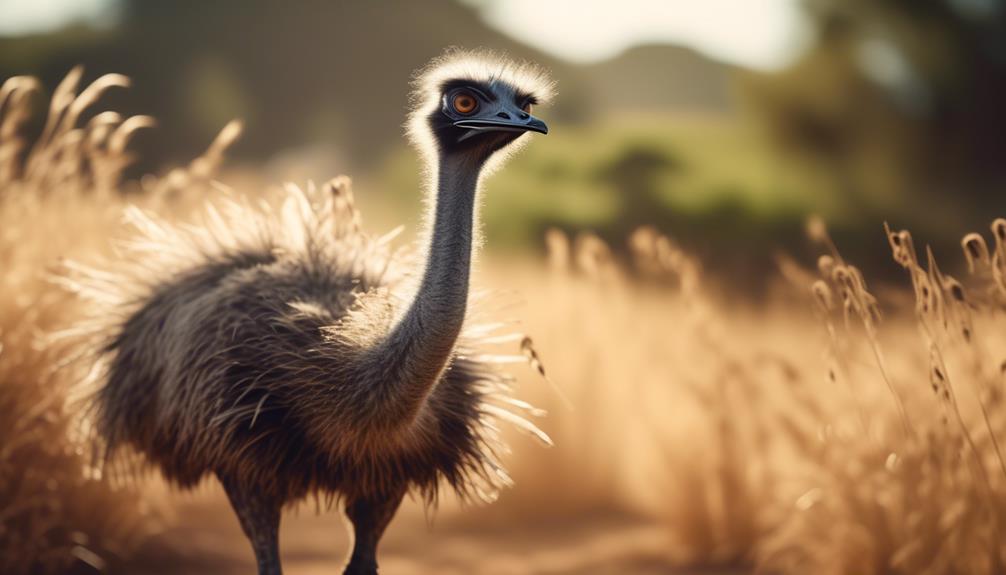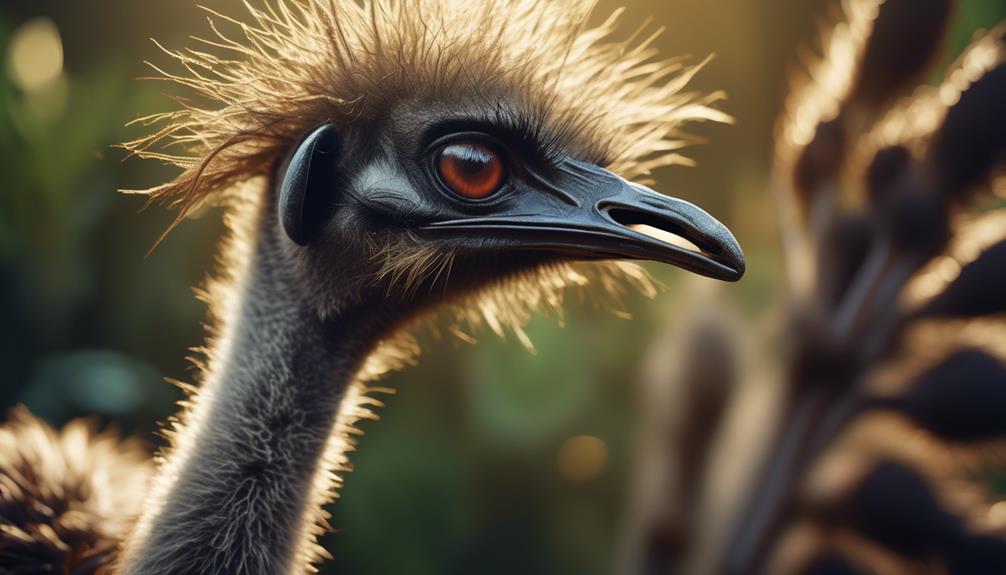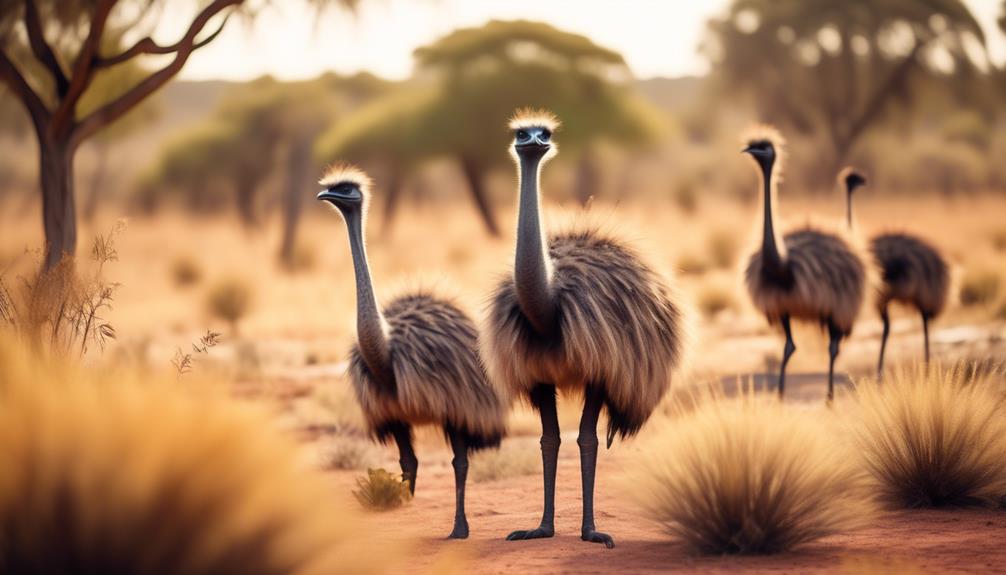
Have you ever considered the crucial role that emus play in maintaining biodiversity and environmental health? These fascinating flightless birds have a unique impact on their ecosystems, influencing everything from seed dispersal to insect populations.
By examining their interactions with plants and animals, we can gain valuable insights into how emus contribute to the delicate balance of our natural world.
So, let's explore the intriguing ways in which emus shape their environment and why their conservation is essential for the overall well-being of our planet.
Emus as Seed Dispersers

Emus play a crucial role as seed dispersers in the ecosystem due to their unique foraging behavior and digestive system.
As habitat restoration becomes increasingly important for maintaining biodiversity and environmental health, understanding the role of emus as ecosystem engineers is essential. Emus, with their large size and powerful beaks, are able to consume a variety of fruits, seeds, and vegetation. When they feed, they often swallow seeds whole, which then pass through their digestive system intact.
This process is crucial for seed dispersal as emus can travel long distances before excreting the seeds in their feces. As a result, emus contribute significantly to seed dispersal, allowing for the colonization and regeneration of plant species in different areas. Their role as seed dispersers is particularly important in disturbed or degraded habitats where natural seed dispersal mechanisms may be limited.
Furthermore, emus are known to selectively consume certain fruits and seeds, thereby influencing the composition and diversity of plant species in their environment. Through their foraging behavior, emus promote the growth of some plant species while inhibiting the growth of others, thus shaping the structure and dynamics of plant communities.
Emus and Vegetation Control
As we shift our focus to the impact of emus on vegetation control, it's important to recognize their role in shaping plant communities through their selective foraging behavior and digestive processes. Emus play a crucial role in maintaining healthy soil by controlling vegetation growth. Their feeding habits involve selectively consuming certain plant species, which helps prevent the dominance of any single plant species and promotes a diverse plant community.
Emus have a unique digestive system that allows them to break down plant material effectively. Their gizzard, a muscular organ, grinds the vegetation, aiding in the breakdown of tough plant fibers. This process helps in the decomposition of plant material, releasing nutrients back into the soil. As a result, emus contribute to improved soil health by enhancing nutrient availability, promoting soil fertility, and increasing microbial activity.
Additionally, emus indirectly influence fire management through their vegetation control behavior. By selectively consuming dry grasses and other flammable plant species, emus reduce the fuel load in an area, making it less prone to wildfires. This natural vegetation control mechanism helps to maintain a balanced ecosystem and reduces the risk of destructive fires.
Understanding the role of emus in vegetation control is vital for effective land management strategies. By recognizing their contribution to soil health and fire management, we can better appreciate the importance of these fascinating birds in maintaining the biodiversity and environmental health of our ecosystems.
Emus' Digestive System and Plant Regeneration

The unique digestive system of emus plays a critical role in facilitating plant regeneration and nutrient cycling in ecosystems. Emus' gut microbiome, consisting of a diverse community of microorganisms, helps them break down plant material efficiently, extracting nutrients that would otherwise go to waste. This process has significant implications for soil fertility and the overall health of the ecosystem.
- Emus' gut microbiome:
- Emus have a specialized fermentation chamber in their digestive system called the cecum, which harbors a complex array of microorganisms.
- These microorganisms, including bacteria and protozoa, aid in the breakdown of cellulose and other complex carbohydrates present in the emus' diet.
- Emus' impact on soil fertility:
- Emus' digestion process enhances nutrient cycling by breaking down plant material into smaller particles, making nutrients more accessible to plants.
- The emus' feces, rich in nitrogen and other essential nutrients, act as natural fertilizers, promoting plant growth and regeneration.
Through their unique digestive system and the symbiotic relationship with their gut microbiome, emus contribute to the overall health and vitality of ecosystems. By facilitating plant regeneration and nutrient cycling, emus play a crucial role in maintaining soil fertility and supporting biodiversity. Understanding the intricate interactions between emus and their environment is essential for effective conservation and management strategies.
Emus' Impact on Insect Populations
The presence of emus in ecosystems has a significant impact on insect populations. Emus are opportunistic feeders and consume a wide variety of insects, playing a crucial role in regulating insect populations and maintaining ecological balance. Their predation dynamics have been observed to have both positive and negative effects on different insect species.
| Emu Predation Dynamics | Effect on Insect Populations |
|---|---|
| Preying on Pest Species | Emus feed on various pest species, including grasshoppers, beetles, and caterpillars, reducing their populations and helping to control outbreaks. This natural form of pest control can alleviate the need for chemical pesticides in agricultural areas. |
| Impact on Beneficial Insects | Emus may also prey on beneficial insects, such as bees and butterflies, which can have negative consequences for pollination and ecosystem health. However, the overall impact on beneficial insect populations is still not well understood and requires further research. |
| Influence on Insect Communities | Emus' foraging behavior and presence in an ecosystem can alter the distribution and composition of insect communities. Their selective feeding habits may favor certain insect species over others, leading to changes in the ecological balance within the system. |
Understanding the interactions between emus and insect populations is essential for effective ecosystem management. Further research is needed to determine the long-term effects of emu predation dynamics on insect communities and to develop strategies that maximize the positive impacts while minimizing any potential negative consequences. By considering the intricate relationships between emus and insects, we can promote the overall health and biodiversity of ecosystems.
Conservation Strategies for Emu-Driven Biodiversity

Emus' impact on insect populations calls for the development of conservation strategies that prioritize the maintenance of emu-driven biodiversity. As emus play a crucial role in controlling insect populations, it's essential to implement effective emu population management and conservation efforts.
Here are some key strategies to consider:
- Habitat preservation: Protecting and preserving the natural habitats of emus is vital for maintaining their population and promoting biodiversity. This includes conserving grasslands, woodlands, and other ecosystems where emus thrive.
- Reducing human-wildlife conflicts: Implementing measures to minimize conflicts between emus and human activities is crucial. This may involve creating buffer zones, implementing fencing, and educating the public about the importance of coexistence.
- Monitoring and research: Regular monitoring of emu populations and their impact on biodiversity is essential for informed conservation decision-making. Research on emu behaviors, breeding patterns, and habitat requirements can inform targeted conservation efforts.
- Collaboration and partnerships: Effective emu conservation requires collaboration among various stakeholders, including researchers, government agencies, landowners, and local communities. By working together, we can develop comprehensive conservation plans and ensure the long-term survival of emus and the biodiversity they support.
Frequently Asked Questions
What Is the Average Lifespan of an Emu?
The average lifespan of an emu is around 10-20 years. Emus are fascinating creatures with unique reproductive behavior and a diverse diet. They play an important role in maintaining biodiversity and environmental health.
Can Emus Fly?
Emus cannot fly. Their adaptations, such as their feather structure, are more suited for running. Their wings are small and their bodies too heavy, making flight impossible.
Are Emus Native to Australia?
Emus are indeed native to Australia. However, when discussing their impact on the ecosystem, it is important to note that they can also be considered an invasive species, affecting the biodiversity and environmental health of certain areas.
How Do Emus Communicate With Each Other?
Emus communicate with each other through a combination of vocalizations and body language. Their unique calls can be described as low booming sounds, while their body language includes head movements and wing displays.
Are Emus Dangerous to Humans?
Emus can be dangerous to humans due to their large size and powerful kicks. While they may seem docile, they can become aggressive if provoked. Additionally, emus can cause agricultural damage if kept as pets.
Conclusion
In conclusion, emus play a vital role in maintaining biodiversity and environmental health.
As seed dispersers, they contribute to the regeneration of plant species, enhancing vegetation control. Their unique digestive system enables them to break down tough plant material, aiding in plant regeneration.
Additionally, emus have a significant impact on insect populations, helping to maintain ecological balance.
Understanding and implementing conservation strategies that prioritize the role of emus is crucial for preserving biodiversity and ensuring a healthy environment for future generations.





